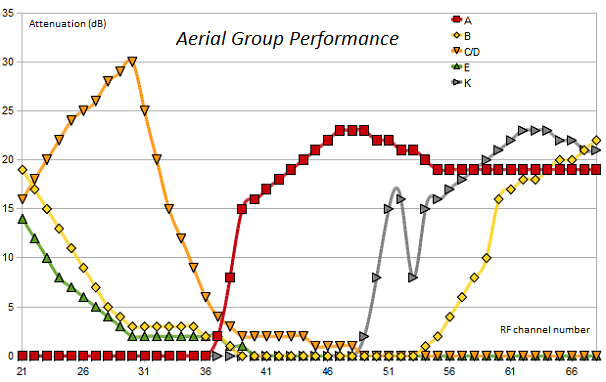Aerial group performance
 Brian Butterworth published on UK Free TV
Brian Butterworth published on UK Free TV Whilst developing the new reception prediction system, I went looking for the reference material relating to the UK Aerial Groups system.
On page 39 of a document entitled "CH61 & 62 Re-Farming Study by Arqiva Final Report 27 October 2008" I found the answers.
To assess the loss of coverage as a result of moving outside of the receive aerial group, account needs to be taken of the performance of receive aerials.
For planning purposes the UKPM assumes that the gain of a receive aerial system is 7dB. This is a somewhat idealised figure based on a good aerial and feeder and no pre-amplifier. The performance of actual receive installations is known to vary considerably from this ideal. Two studies, one for the Virgin consortium that bid for the Channel 5 licence in 1995 and the other for the ITC in 2004 investigated the actual received level for a large sample of domestic installations. This study considered aerial group but not the performance of actual receive installations.
In addition to variability in receive aerial system gain, most aerials are banded and their performance falls away outside their design operating band. The ITC as part of the documentation for the original DTT plan, Notes for applicants on coverage of Digital Television, October 1996, listed the out of group response of representative receive aerials.
I have reproduced the information from the table as a graph. The values are the attenuation (in dB):

It is interesting to note that in group A, C37 is -2dB and "in group", group B, C35 is -3dB and C36 is -2dB and "in group", group C/D has C48 on -1dB and "in group" and group E has C37 or -2dB and C38 and C39 on -1dB and be "in group".
8:16 AM
Moss : Well, up to a point anyway, that can be quite true!, but one gets what one pays for as far as construction (ruggedness) is concerned, even although the receptive qualities of some cheaper alternative products can be very similar to that of the more expensive equivalents.
However, the item advertised in the undermentioned link could well be of interest.
32 Element DIGITAL Freeview High Gain TV Aerial - Great Unix 32 alternative! | eBay
| link to this comment |
1:57 AM
Hull
Hi i live in hull east yorkshire. near wane and was wondering which type of tv aerial would be best could you please help as im having difficulty choosing correct one.Wanted to no which transmitter group i was in i.e. A,B,C POST CODE IS HU7 5DG.http://www.digitaluk.co.uk/coveragechecker/main/trade/hu7+5dg/24/0/99cnn6frru05766kjad4qbraf6
| link to this comment |
Mark's: mapM's Freeview map terrainM's terrain plot wavesM's frequency data M's Freeview Detailed Coverage
1:37 PM
Mark:
According to the 'digitaluk trade' information just below your posting you're best transmitter is Belmont, which is a Group A transmitter. However, I advise that you use a log-periodic aerial that will cover all current and future transmissions, so alleviating any need for further change. Take a look at Online FM DAB TV Aerial sales as a good example of such. I use one and it is excellent. Other makes and suppliers are available.
Do not allow yourself to be misinformed about needing a 'digital' aerial, *all* aerials for TV use in the UK are capable of receiving the RF transmissions and the method of encoding the information is irrelevant to the aerial.
| link to this comment |
10:51 PM
Hi, I live in Peacehaven east sussex, although newhaven is nearest whitehawk hill in brighton would give me more channels. Can you advise which type of aerial would best suit. Thank you.
| link to this comment |
10:22 AM
Dave:
You would be best fitting a log-periodic aerial externally. They cover all the current and known future transmissions so will not need any further change.
To assist you with whether you can actually get reliable reception from either transmitter we would need a full post code, Peacehaven is not specific enough to determine what the reception conditions are like at your location.
| link to this comment |
9:36 AM
Please advise which aerial group is best for PE19 , 4 miles as crow flies from Sandy Heath transmitter.
| link to this comment |
1:54 PM
Barry: At 4 miles away a log periodic would be ideal, even a small one such as a DM log should be fine.
| link to this comment |
If Rowridge has moved some of its output to the 600mhz carrier, then I am not going to be able to receive them on the recommended group A aerial. If I wish to continue to access TV programmes such as TV Channel 94, what additional group aerial do I need to erect such that I can choose between the two aerials?
| link to this comment |
11:33 PM
Norman Langridge: A wideband aerial will get you all the channels broadcast from Rowridge. There is no need to combine two grouped aerials, it just over complicates things (the use of wideband aerials has been recommended by the BBC, etc since digital terrestrial TV broadcasts began around 20 years ago). If you don't have satellite or cable you may be eligible to have a free replacement wideband aerial fitted, which can be arranged by contacting the Freeview Advice Line (see link below).
Important changes to Freeview TV signals | Freeview
| link to this comment |
3:29 PM
The Halidon Hill transmitter that serves 2200 homes in the Berwick upon Tweed area only has limited number of tv channels . Why do we have to put up with a limited service compared to other areas who have hundreds of channels?
| link to this comment |